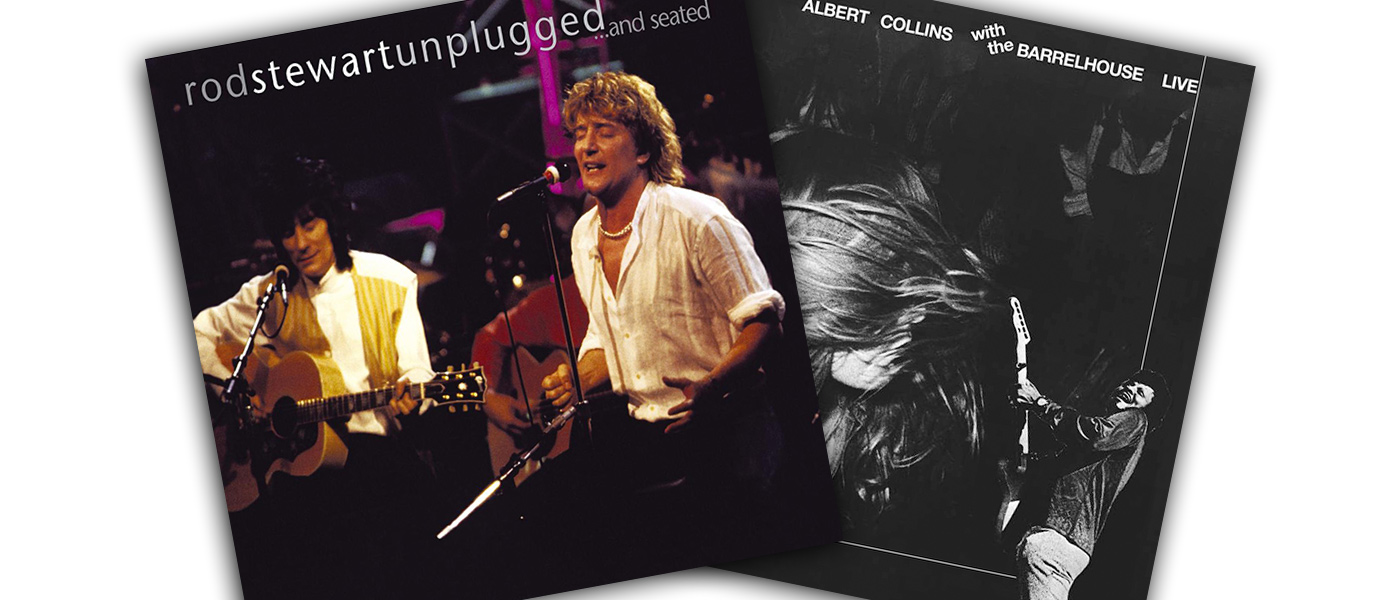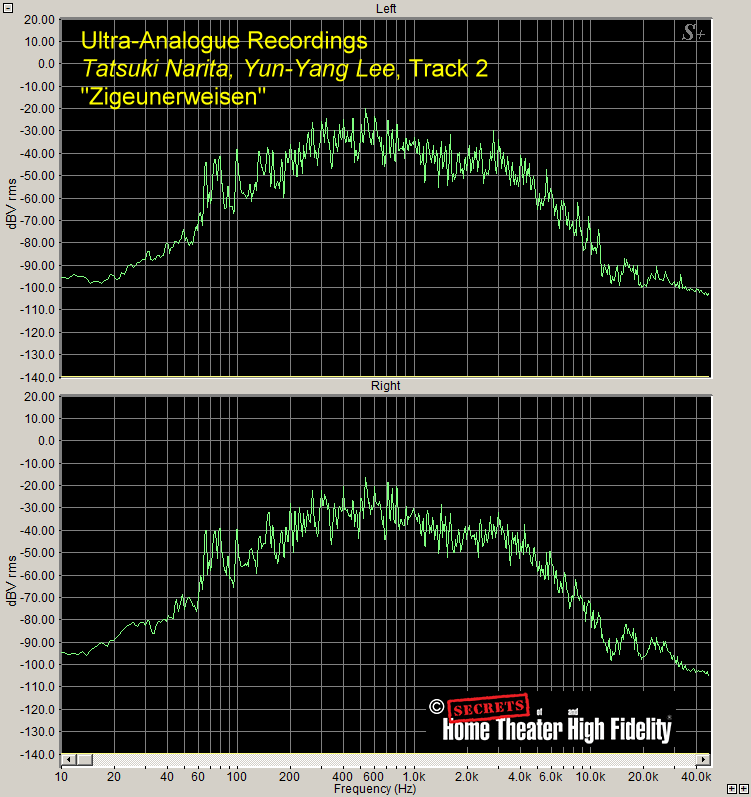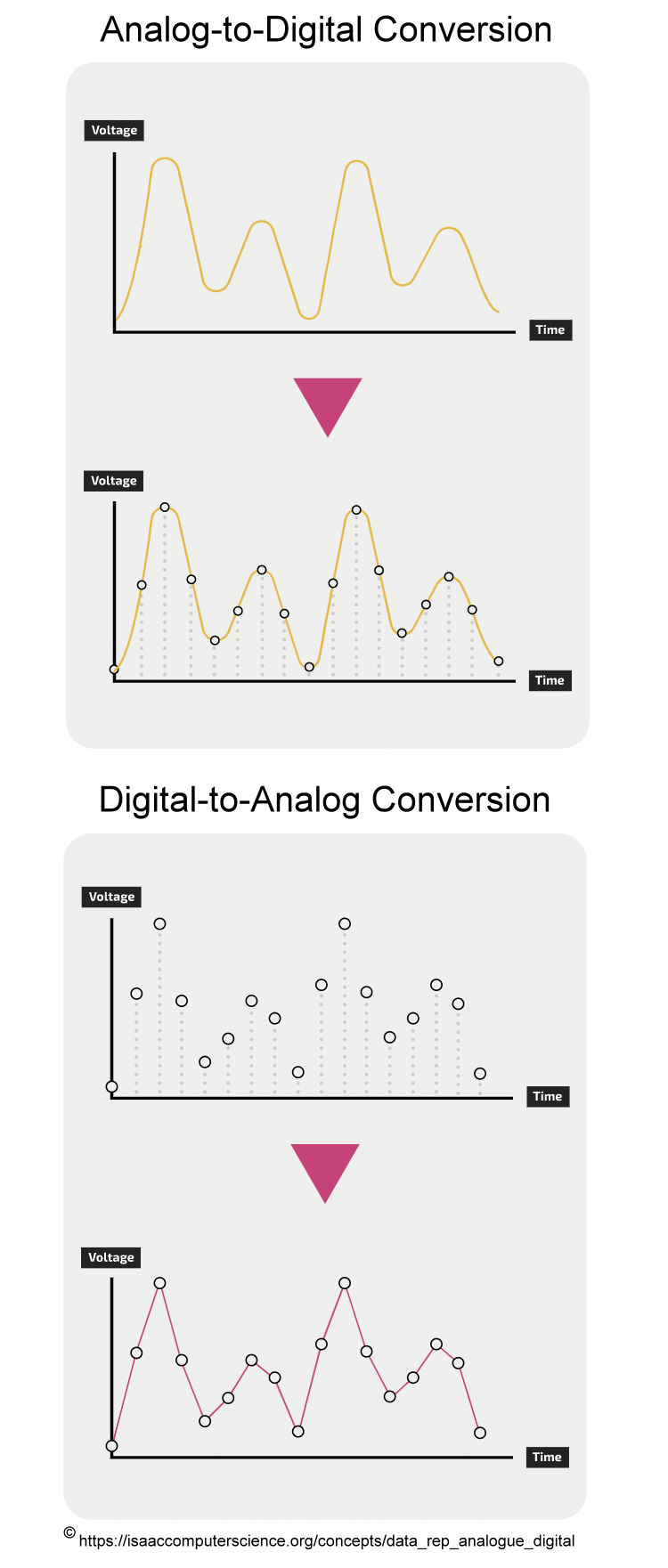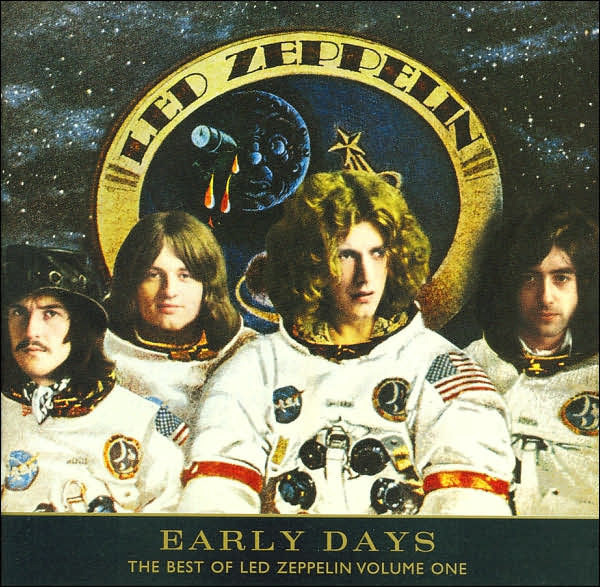
Led Zeppelin, The Early Days Vol. 1, Atlantic Records, 1999, CD.
In the late ’60s and early ’70s, we saw the “Greatest Rock n Roll Band” baton handed off to some truly exciting new groups, and none was bigger than Led Zeppelin. This was the time of AM transistor radios and FM stereo competing for listeners. AM had range and FM had quality.
My brother and I would spend summer evenings trying to pick up the Detroit Rock station CKLW on our transistor radio. Camping out in the backyard, and getting occasional songs from Led Zeppelin, The Doors, 3 Dog Night and Grand Funk Railroad was a treat.
50 years later, we no longer need to listen to rock on a 1-inch paper cone. The Early Years lets us experience Robert Plant and the group in wonderful stereo. Two songs of note (and yes, they are ALL of note) are “The Immigrant Song” and “The Battle of Evermore”. The hard-driving of Immigrant will bring out the air guitarist in a Tuba player, while the harmonics from Evermore never sounded this good. The collection is over an hour of great song after great song and is one of my go-to discs when I need to chill out.
Secrets Sponsor
If you want an escape to a time when Rock n Roll was awesome, check out this collection. Prepare your favorite adult beverage and lock yourself away from the world for an hour (or 2, if you add Latter Days) of one of the all-time greatest bands.
Reel-to-Reel Tape-Recording Reviews
International Phonograph, Inc., Jazz Sampler Number One.
15 IPS, IEC EQ, ¼” Half-track, Copy of the Production Copy (also called Copy of the Running Master, or Second-Generation Copy), 10.5” Reel, $150
https://www.internationalphonographinc.com/master-tape-copies
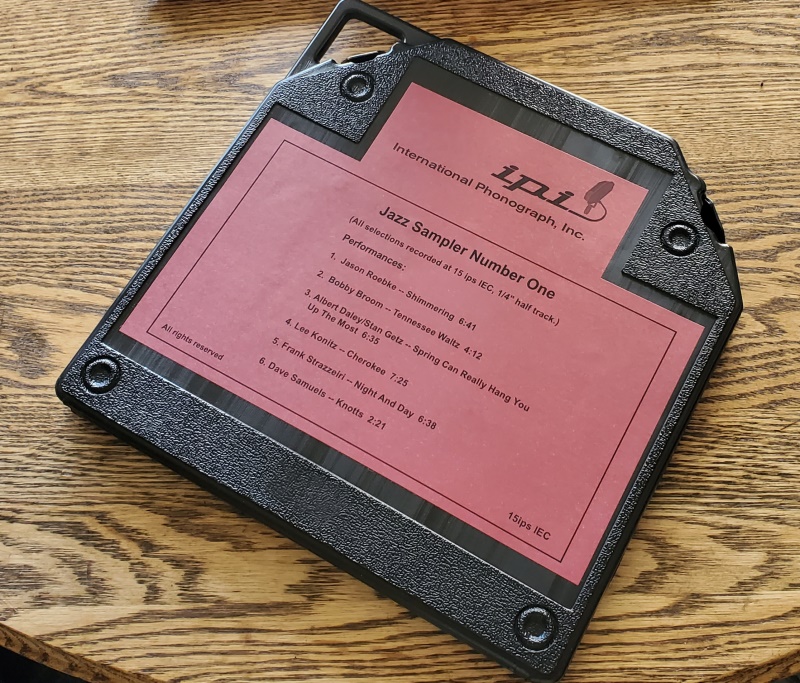
This review marks my first entry into Reel-to-Reel (RTR) music tapes that are commercially available to those of us who are lucky enough to own an RTR tape deck. I purchased an Otari MX-5050B-III-2 deck a few months ago from Reel to Reel Heaven (https://reeltoreelrestoration.com/), and I decided to try out some music tapes. I was a bit hesitant about this, as some of them are very expensive, and I was afraid I might be wasting my time and money. However, I did manage to find a few companies that market tapes at reasonable prices. One of them is International Phonograph, Inc., which is based in Chicago, Illinois. After corresponding with the owner, Jonathan Horwich, I purchased their Jazz Sampler Numbers One and Two. They arrived in a carefully packed box by UPS a few days ago.
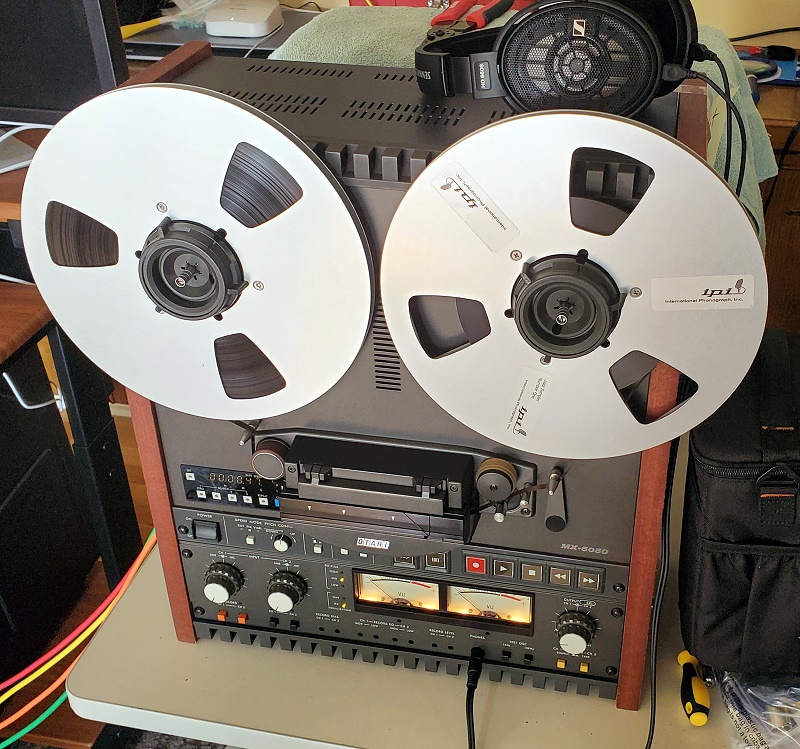
Music tapes are usually supplied as what is called “Tails Out”. This means that you are supposed to put the tape on the right side of the deck and rewind the tape onto a blank reel on the left side. Then you play the tape onto the original reel. The reason for this is that by storing the tape as tails out, you reduce the amount of print-through which is sound from one portion of the tape printing through onto tape that is wound against it in the reel. Even some blank tape is described as being sold on the reel tails out, but since the tape is blank, to me, there is no tails out.
So, I wound the tape onto a blank reel and started playing it. I used a Sennheiser HD 660S set of headphones (about $450) (https://en-us.sennheiser.com/hd-660-s) plugged into the ¼” stereo phone jack on the deck. These headphones are excellent for this purpose. Deep no-boominess bass, clear midrange, no treble harshness at all.

I would suggest turning the volume to the headphones all the way down to start with, as the recording Reflux can be high on some tapes. This one was recorded at 250 nWb/m (nano-Webers per meter), which is the setting that I use for my own recordings. Reflux is the intensity of magnetism used to magnetize the metal particles on the tape. Very high-quality tape has to be used for high reflux. The UltraAnalogue tape that I will be discussing shortly was recorded at 396 nWb/m, and when I started playing it, I had not turned down the volume on the headphones and was practically blown out of the room. Higher reflux recordings have lower noise, but slightly more harmonic distortion.
Anyway, Jazz Sampler Number One has six tracks. The first one, “Shimmering”, by the Jason Roebke jazz ensemble starts out with a bass solo, then xylophone comes in followed by tenor sax and drums. I have to say that it took my breath away. The clarity, detail, presence, body, smoothness, whatever complimentary nouns or adjectives that can be applied, are applied. I have never heard a sound like this before, anywhere or anytime.
Here is a frequency response spectrum from track 2, Bobby Broom Trio, “Tennessee Waltz”. It extends out to about 20 kHz. The peak at 32 kHz is some noise (inaudible). This track is from Bobby Broom, Sweet and Lovely, recorded in March of 2014 in Chicago.

Notice that the low-end response drops off sharply below about 60 Hz. For magnetic tape audio, the low-end frequency response is determined by the tape head pole length and contact face width. Very low frequencies require a long pole length. The higher the tape speed, the longer the pole length has to be to record the low frequencies. That is why the low-end frequency response at 15 IPS is not quite as good as at 7.5 IPS. (The diagram below has been modified from the original.)
The high-end frequency response is determined by the gap width and the type of tape being used. Gap wear reduces the high-end frequency response. In the diagram shown below, you can see that when the wavelength gets shorter (with increasing frequency), and finally is the same as the width of the tape head gap, there is no longer any output. When the + and – peaks of the positive and negative portions of the waveform are the same width as the tape head gap, that is the maximum high frequency, with higher frequencies response decreasing rapidly.
There are some studio tape deck heads with very long pole lengths and very narrow gaps that will deliver better FR, but that is not what the consumer ends up with in most tape decks.
The third track, “Spring Can Really Hang You Up the Most”, with Stan Getz on tenor sax is spectacular. For such an old master tape, I am surprised. The frequency response is out to 20 kHz. There is a spurious peak at 26 kHz. The high peaks in the midrange are some of the notes he is playing. The other peaks are harmonics of his notes, not harmonic distortion. The recording is so wonderful, I plan to buy the full album tape.
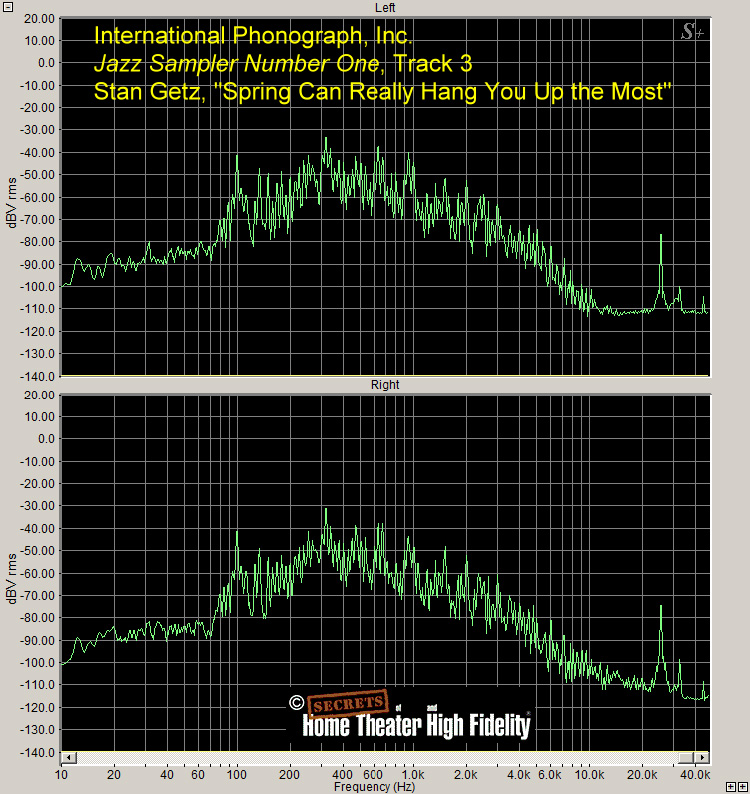
A copy (second generation) of the Production Master (Running Master) is different from a first-generation direct copy of the master only in a couple of dB more background hiss. As long as excellent decks are used for the copies, that is what happens. The frequency response is pretty much intact. For further copies, say third or fourth-generation, which might be what happens when multi-track decks are used, with mixing and editing, then down-mixed to two-track and then copied for cutting lacquers for vinyl, yes, there will be some deterioration. Not much, but it happens. However, for the type of music tapes reviewed here, where the copy is at most, second-generation (a copy of the Production Master which is a direct copy of the original master tape), with no down-mixing, the quality is simply amazing. This is better than vinyl and better than digital, but that is just my opinion. However, I have been listening to high-end audio for more than half a century. Note that I have found confusion in the literature about what is first-generation and second-generation. All you need to know is whether the tape you purchase is a copy of the original recording master tape or a copy of the copy of the original recording master tape. They are generally sold in these two versions. Make sure you know what you are getting.
Tapes from International Phonograph, Inc. are available as second-generation copies for $150 and first-generation copies for $250. If you purchase a new release right away, you can get the first-generation copy for $150. That, my friends, is a bargain.
The other tracks are all very different from one another because they are tracks from various other albums that they market. I recommend the samplers because you get great music, but, you also can choose to get the full albums of the tracks that you really like. That is what I plan to do. I also plan to get occasional albums when they are first released, as direct copies from the master tape, at $150.
Interestingly, they also included a cookbook that Jonathan and his partner authored. It is a very nice book, and while I started listening to the tapes, my wife Susan started in on one of the recipes. The cookbook is free to customers and $20 including shipping for everyone else.
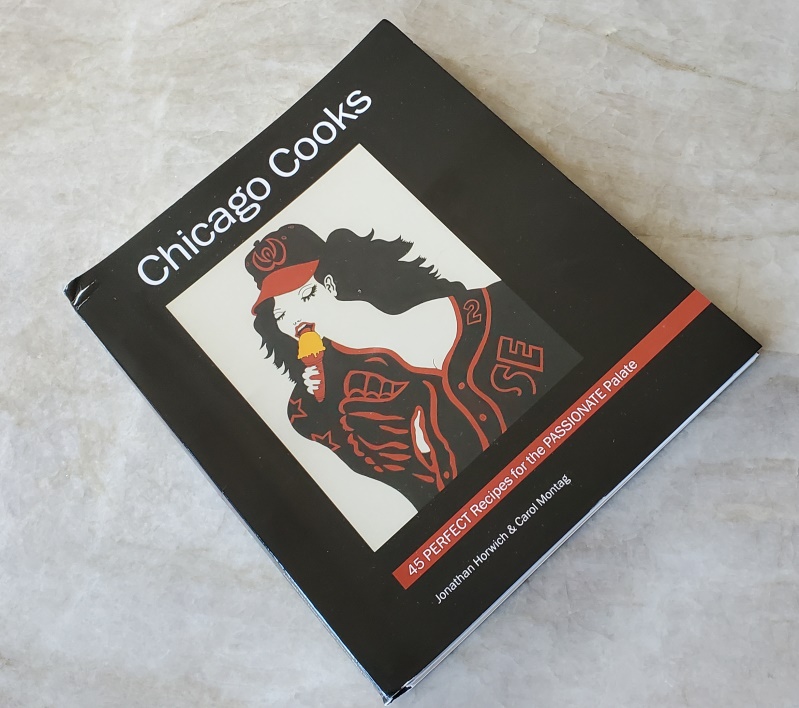
UltraAnalogue Recordings, Tatsukin Narita, Violin, Yun-Yang Lee, Piano
15 IPS, IEC EQ, ¼” Half-track, Copy of the Production Copy (also called Copy of the Running Master, or Second-Generation Copy), 10.5” Reel, $295
https://ultraanaloguerecordings.com/new/shop/instrument/full-tape-catalog/

UltraAnalogue Recordings markets copies of tapes that they record themselves of various musicians. Copies of the Production Masters (Running Masters) are sold to consumers. The tapes are recorded and copied on RMG SM900 tape with Studer A80 professional tape decks. Custom-built tube recording and playback amplifiers are also employed. The reflux is 396 nWb/m which is very high (gives lower noise but a bit more harmonic distortion), and indeed I really could not hear any hiss. I thought I could at first, but after listening more at length, I think it was just background noise in the room where the music was recorded. I use 250 nWb/m when I record, which is the norm. Here is a photo of the two musicians playing the “Zigunerweisen” track by Pablo de Sarasate.
As a result of the high reflux, you need to be careful when you hit the Play button. If your deck is calibrated for 250 nWb/m, the volume might too high. Turn the volume control on your deck or preamplifier all the way down, hit Play, and then increase the volume. The pair of Sennheiser HD 660S headphones that I use for listening and review of the tapes keeps the personality of my preamplifier and power amplifiers out of the sound quality. These headphones are really nice, very comfortable, and deliver great sound.
The five tracks are “Danse Macabre” by Camille Saint-Saens, “Zigeunerweisen” by Pablo de Sarasate, “Bloch Nigun” by Bloch, “Introduction & Tarantella” by Pablo de Sarasate, and “Meditation” by Jules Massenet, all composed in the late 1800’s and early 1900’s.
Secrets Sponsor
The sound is just marvelous. They used a special bow for the violin, and I have to say I have never heard a violin sound so “actually in front of me”. The piano is also beautifully recorded.
Here is a spectrum from track 2.
The frequency response is well out to 30 kHz, maybe even a little bit out to 35 kHz. This is the practical limit of tape. We can’t hear much above 20 kHz, especially as we age, so the reality of 35 kHz is perhaps something that we can sense but not put our finger on what it is.
The entire tape is a standard by which I wish all tapes, including the stuff that was done back in the 1960s, were recorded. I will have to suffice with modern tapes from high-quality sources. UltraAnalogue Recordings gets my definite recommendation.
Modern tape recordings played on classic tape decks sound, to me, better than any other source I have heard. The precaution is that you need to choose your tape sources carefully. Tapes from decades ago were recorded at very high speed on cheap tape. They are usually 7.5 IPS and some are at 3.75 IPS. They will not sound as good as the two tapes I have reviewed here.
Why does tape sound better than digital? Well, keep in mind this is just my opinion.
Analog music is represented on tape and vinyl by a continuous voltage throughout the waveforms. Digital music is represented by a series of samples that represent voltages on the waveform. The samples are coded by a series of 16 or 24 (32 is the latest) bits that represent the voltages. Shown below is a bitstream, voltage vs. time. The bits are either 0’s or 1’s, and a 0 is coded by a specific length of time as 0 Volts, while a 1 is coded as 5 Volts (other voltage values are sometimes used, such as 1.8 Volts).

During recording, Analog-to-Digital Conversion (ADC) is used to encode the musical waveform, as shown below in the top portion of the figure. The dots on the waveform are the samples. During playback, Analog-to-Digital Conversion (DAC) is used to decode the digital bitstream into an analog waveform (bottom of the figure shown below).
Notice that the decoded signal is not a true representation of the original musical waveform. Mathematically separating out the frequencies in this waveform gives a large number of harmonics that were not in the music. So, the signal is filtered, removing as much of these harmonics as possible, leaving only the original frequencies. This is not a perfect procedure. For 20 kHz, there are only two samples for each complete waveform using 16/44.1 sampling. The result is a huge number of harmonics in the decoded waveform. That is why a strong low-pass filter is used at 22 kHz, which removes (reduces) the harmonics at 40 kHz, 60 kHz, etc. At 10 kHz, there are four samples. That also decodes to a signal that has harmonics. The filter does not remove the 20 kHz harmonic but does reduce it somewhat due to the low-pass filter not being a straight up and down wall.
Let’s take 5 kHz. It has eight samples. The decoded signal still has harmonics. The 2nd ordered harmonic at 10 kHz and 3rd harmonic at 15 kHz are not removed. The harmonics are small, but still, they are there. There are also quantization errors and jitter. With increased sampling frequency, the harmonics are less because there are more samples, but the decoded waveform is never a perfect representation of the original. Just, very close.
The advantages of digital are that perfect copies can be made so there is no sequential generation degradation. Digital also has somewhat lower distortion and lower noise. With the DAC chips being so terrific these days, the really important part of the DAC is the analog output stage. Keep this in mind when purchasing a DAC. A really inexpensive DAC will not have a strong output stage that can drive a preamplifier if the preamp does not have a high input impedance.
Anyway, regardless of all the arguments about analog vs. digital, this is what I prefer. I do listen to a lot of digital music because that is what is mostly available. Analog music products are a very small percentage of recorded music. Also, like vinyl, using tape is very inconvenient. You have to rewind the tails-out tape to play it. Cueing to a particular track is easy with digital and vinyl, but not easy with tape. Vinyl and tape require mechanical contact with the sensor (stylus or tape head) so the sensor and vinyl and tape wear with use. I use a streaming service and love to listen. Digital sounds great. But tape sounds better (to me). So, I now have both and will enjoy them both.


